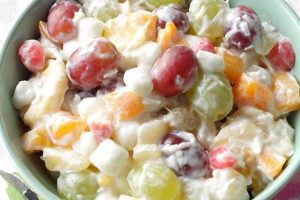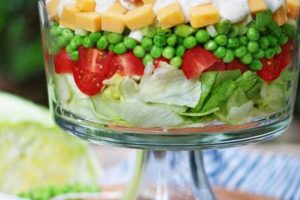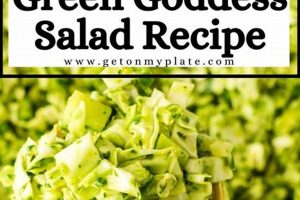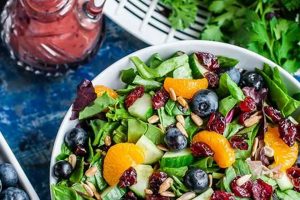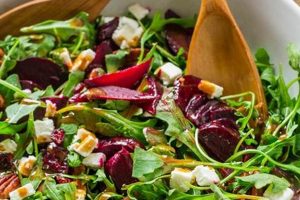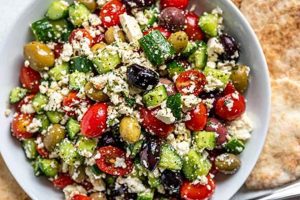Fresh, seasonal produce combined with creative dressings and complementary ingredients offers a lighter counterpoint to rich holiday meals. Examples include cranberry and walnut salads for Thanksgiving, citrus and fennel salads for winter celebrations, or vibrant grilled vegetable salads for summer barbecues. These dishes can be simple or elaborate, adapting to the occasion and the preferences of the diners.
Holiday meals often feature calorie-dense dishes. A well-crafted salad provides a refreshing contrast, offering essential vitamins and nutrients. Historically, specific ingredients have been associated with celebrations, lending symbolic meaning to the dishes served. This tradition continues today, with salads often reflecting the flavors and ingredients representative of a particular holiday. Furthermore, salads can be prepared in advance, reducing stress for the host and allowing more time for other aspects of the celebration.
The following sections explore various festive salad options, categorized by season and holiday, offering inspiration and guidance for creating memorable dishes. Topics covered will include ingredient selection, preparation techniques, and suggested pairings to enhance the overall dining experience.
Tips for Creating Festive Holiday Salads
These tips offer guidance for elevating holiday salads from simple side dishes to memorable culinary creations.
Tip 1: Embrace Seasonality: Selecting ingredients at their peak ripeness ensures optimal flavor and vibrancy. Winter holidays benefit from citrus fruits, pomegranates, and hearty greens like kale. Summer celebrations call for ripe tomatoes, cucumbers, and fresh herbs.
Tip 2: Balance Flavors and Textures: Consider the interplay of sweet, savory, acidic, and bitter elements. Incorporate a variety of texturescrispy, creamy, crunchyfor a more engaging culinary experience. A salad with roasted sweet potatoes, pecans, goat cheese, and cranberries exemplifies this balance.
Tip 3: Dress Strategically: The dressing should complement, not overpower, the salad’s components. Lighter vinaigrettes are ideal for delicate greens, while creamy dressings pair well with heartier ingredients. Consider making dressings from scratch to control the flavor profile and avoid unnecessary additives.
Tip 4: Plan and Prepare: Many salad components can be prepared in advance. Washing and chopping vegetables, toasting nuts, and making dressings ahead of time streamlines the process and reduces stress on the day of the celebration.
Tip 5: Consider Presentation: Thoughtful plating enhances the visual appeal. Use attractive serving bowls, arrange ingredients artfully, and garnish with fresh herbs or edible flowers for an elegant touch.
Tip 6: Offer Variety: Providing multiple salad options caters to diverse dietary needs and preferences. Consider offering a classic green salad alongside a more composed option, such as a roasted vegetable or grain-based salad.
Tip 7: Don’t Forget the Herbs: Fresh herbs add brightness and complexity. Parsley, cilantro, mint, and dill can elevate a simple salad, while more robust herbs like rosemary and thyme can complement heartier ingredients.
By following these tips, one can create salads that not only complement the holiday meal but also become a highlight of the celebration.
The following section provides specific recipe ideas, incorporating these principles to inspire culinary creativity for upcoming festivities.
1. Fresh, Seasonal Ingredients
Holiday celebrations often center around sharing meals with loved ones. Utilizing fresh, seasonal ingredients in salads elevates these dishes, reflecting the unique flavors of the specific time of year and contributing to a more memorable dining experience. Seasonality offers not only optimal taste but also supports local agriculture and reduces environmental impact.
- Peak Flavor and Nutritional Value
Ingredients harvested at their peak ripeness offer the most robust flavor and highest nutritional content. A summer salad bursting with ripe tomatoes and cucumbers showcases this principle. These ingredients require minimal embellishment, allowing their natural flavors to shine. Conversely, winter salads benefit from hearty greens like kale and seasonal citrus fruits, providing essential vitamins and a welcome contrast to heavier holiday fare.
- Variety and Culinary Inspiration
Each season offers a unique array of produce, inspiring culinary creativity and preventing menu fatigue. Spring salads might feature asparagus and fresh peas, while autumn celebrations call for apples, pears, and root vegetables. This natural variation allows for a diverse range of salad combinations throughout the year, catering to different tastes and preferences.
- Supporting Local Food Systems
Choosing seasonal ingredients often means sourcing produce from local farms and markets. This practice supports local economies, reduces transportation costs and associated environmental impact, and strengthens community connections. Incorporating locally sourced ingredients into holiday salads adds another layer of meaning to the meal.
- Enhanced Visual Appeal
Seasonal ingredients often exhibit vibrant colors and textures, enhancing the visual appeal of holiday salads. The deep reds of winter berries, the bright greens of spring herbs, and the rich oranges of autumn squash all contribute to visually stunning dishes that entice the appetite and add to the festive atmosphere.
By prioritizing fresh, seasonal ingredients, holiday salads become more than just a side dish; they transform into a culinary expression of the specific time of year, celebrating both the bounty of nature and the joy of gathering with loved ones. The connection between seasonality and festive meals strengthens the overall dining experience, making it more meaningful and memorable.
2. Balanced Flavor Profiles
Balanced flavor profiles are crucial for successful holiday salads. The interplay of sweet, sour, salty, bitter, and umami creates a dynamic sensory experience that elevates a salad from a simple side dish to a memorable component of the meal. This balance prevents any single flavor from dominating, allowing for a more nuanced and enjoyable culinary experience. For example, a Thanksgiving salad might incorporate the sweetness of roasted butternut squash, the tartness of cranberries, the saltiness of pecans, and the bitterness of radicchio. A well-balanced vinaigrette, perhaps with maple syrup and Dijon mustard, further enhances this complexity. This approach ensures that each bite offers a harmonious blend of flavors, complementing the richer dishes often served during holiday meals.
Achieving flavor balance requires careful consideration of ingredient selection and proportion. The intensity of each flavor element must be taken into account. A small amount of a strong cheese, such as blue cheese, can provide a pungent counterpoint to sweeter elements. Similarly, a squeeze of lemon juice can brighten a salad and cut through richer flavors. Understanding these interactions allows for precise flavor adjustments, tailoring the salad to the overall meal and the preferences of the diners. A holiday salad designed to accompany a heavily spiced main course might emphasize brighter, acidic notes to provide a refreshing contrast. Conversely, a salad served alongside lighter fare might benefit from richer, more savory components.
Mastering flavor balance in holiday salads significantly enhances the overall dining experience. It demonstrates culinary expertise and attention to detail, transforming a simple dish into a sophisticated culinary creation. Moreover, a well-balanced salad can act as a palate cleanser, preparing diners for the next course and preventing flavor fatigue. This understanding of flavor dynamics enables the creation of salads that not only complement the holiday meal but also stand out as memorable dishes in their own right.
3. Complementary Textures
Textural diversity significantly enhances holiday salads, transforming them from simple accompaniments into engaging culinary experiences. The strategic combination of contrasting textures adds depth and complexity, making each bite more interesting and satisfying. This element is particularly relevant for holiday meals, which often feature rich, homogenous dishes. Salads with varied textures provide a welcome contrast, stimulating the palate and enhancing the overall meal.
- Crisp and Crunchy Elements
Ingredients like romaine lettuce, raw vegetables (carrots, celery, bell peppers), croutons, nuts, and seeds contribute crispness and crunch. These textures provide a refreshing counterpoint to softer ingredients and add a satisfying auditory element to the eating experience. In a holiday context, toasted nuts or pomegranate seeds can add a festive touch while contributing textural complexity.
- Soft and Tender Components
Cooked vegetables (roasted sweet potatoes, steamed green beans), soft cheeses (goat cheese, feta), and avocado offer a smooth, creamy contrast to crisper elements. These textures contribute richness and depth, balancing the overall composition of the salad. For a holiday meal, roasted root vegetables or wilted greens can add warmth and seasonal flavor while offering textural contrast.
- Chewy and Hearty Additions
Dried fruits (cranberries, apricots), grains (quinoa, farro), and legumes (chickpeas, lentils) introduce a chewy texture that provides a satisfying mouthfeel. These elements can also contribute substantial protein and fiber, making the salad more filling and nutritionally balanced. Dried cranberries are a classic addition to Thanksgiving salads, offering both a festive touch and textural variation.
- Creamy Dressings and Toppings
Dressings play a crucial role in textural balance. While vinaigrettes provide a light coating, creamy dressings made with yogurt, sour cream, or avocado add a richer, smoother element. Toppings like crumbled cheese or toasted coconut flakes further enhance textural diversity. For a holiday salad, a creamy dressing can complement roasted vegetables and add a touch of decadence, while a lighter vinaigrette might be preferred for a salad with delicate greens.
The interplay of these diverse textures elevates holiday salads, creating a more engaging and satisfying dining experience. By thoughtfully combining crisp, soft, chewy, and creamy elements, these dishes become more than just a side; they contribute a dynamic textural dimension to the holiday meal, complementing richer dishes and offering a refreshing contrast. This attention to texture demonstrates culinary skill and elevates the overall enjoyment of the festive occasion.
4. Appropriate Dressings
Dressing selection significantly impacts the overall success of holiday salads. A well-chosen dressing complements the other ingredients, enhancing their flavors without overpowering them. It also contributes to the salad’s overall texture and visual appeal. During holidays, dressings can be tailored to reflect seasonal flavors and the specific dishes being served, further elevating the dining experience. An appropriate dressing harmonizes with the salad’s components, creating a cohesive and enjoyable culinary composition.
- Flavor Compatibility
The dressing’s flavor profile should harmonize with the salad’s ingredients. A light vinaigrette complements delicate greens and vegetables, while a creamy dressing pairs well with heartier components like roasted vegetables or grains. For a Thanksgiving salad with roasted butternut squash and cranberries, a maple-pecan vinaigrette provides complementary sweetness and nuttiness. Conversely, a winter citrus salad might benefit from a bright, citrusy vinaigrette. Careful consideration of flavor pairings ensures a balanced and delicious salad.
- Texture and Consistency
Dressing consistency influences the salad’s overall texture. A light vinaigrette adds a subtle coating, while a creamy dressing adds richness and body. The choice depends on the other ingredients and the desired outcome. A creamy avocado dressing complements a Southwestern-inspired salad with black beans and corn, while a light balsamic vinaigrette enhances a Caprese salad with fresh mozzarella and tomatoes. The dressing’s texture should integrate seamlessly with the other components, creating a harmonious mouthfeel.
- Visual Appeal
The dressing contributes to the salad’s visual presentation. A vibrant vinaigrette adds a pop of color, while a creamy dressing provides a smooth, cohesive appearance. The dressing should enhance the visual appeal of the salad without obscuring the other ingredients. A bright green pesto dressing adds visual interest to a pasta salad, while a creamy ranch dressing complements a classic wedge salad. The visual element of the dressing should be considered in relation to the overall presentation of the holiday meal.
- Dietary Considerations
Dietary restrictions and preferences influence dressing selection. Lighter vinaigrettes are generally lower in calories and fat than creamy dressings. Offering a variety of dressings, including low-fat or vegan options, caters to diverse needs. For a holiday gathering, providing both a creamy dressing and a lighter vinaigrette allows guests to choose according to their preferences. This consideration demonstrates attentiveness to individual dietary needs and enhances the overall dining experience.
Selecting appropriate dressings for holiday salads elevates these dishes beyond simple accompaniments. By considering flavor compatibility, texture, visual appeal, and dietary needs, dressings can be chosen to enhance the overall dining experience. A well-dressed salad complements the other dishes served during holiday meals, providing a refreshing counterpoint and demonstrating culinary expertise. This attention to detail transforms a simple salad into a memorable component of the festive occasion.
5. Creative Presentation
Creative presentation elevates holiday salads from simple side dishes to visually appealing centerpieces, enhancing the overall dining experience. Holidays offer opportunities to showcase culinary creativity, and salad presentation provides a canvas for artistic expression. Thoughtful plating arrangements, the use of garnishes, and the choice of serving vessels contribute to a visually engaging dish that complements the festive atmosphere. For example, a Christmas salad might be arranged in a wreath shape on a platter, using red and green ingredients like cranberries and spinach to create a visually festive composition. Alternatively, individual portions of a Thanksgiving salad could be served in hollowed-out mini pumpkins, adding a touch of seasonal charm.
The impact of creative presentation extends beyond mere aesthetics. A visually appealing salad entices the appetite and generates excitement for the meal. It demonstrates attention to detail and a commitment to providing a memorable dining experience. This is particularly important during holidays, when meals often hold symbolic significance and serve as focal points for gatherings. Furthermore, creative presentation can influence perceptions of flavor. A beautifully arranged salad suggests care and effort in its preparation, leading diners to anticipate a more enjoyable culinary experience. The practical application of this understanding allows hosts to create dishes that not only taste delicious but also contribute to the overall festive ambiance.
In conclusion, creative presentation plays a crucial role in the success of holiday salads. It transforms functional dishes into visually captivating centerpieces, enhancing the dining experience and contributing to the festive atmosphere. By understanding the impact of visual appeal on appetite and perception of flavor, one can leverage creative presentation techniques to elevate holiday meals and create lasting memories. This attention to detail transforms simple salads into memorable components of the holiday celebration.
6. Dietary Considerations
Dietary considerations play a crucial role in planning holiday meals, particularly when it comes to salad recipes. Food allergies, intolerances, and specific dietary choices (vegetarian, vegan, gluten-free, etc.) require careful attention to ensure all guests can enjoy the meal. Failing to accommodate dietary restrictions can lead to discomfort, health issues, and social exclusion. Therefore, understanding and addressing these considerations demonstrates hospitality and inclusivity.
One common approach is to offer a variety of salads to cater to different needs. A traditional Caesar salad can be offered alongside a vegan option made with a cashew-based dressing. Similarly, a gluten-free grain salad can complement a pasta salad. Providing clear ingredient lists, including potential allergens, allows guests to make informed choices. This practice not only prevents adverse reactions but also allows guests with dietary restrictions to feel included and valued. For guests with severe allergies, dedicated preparation areas and utensils can prevent cross-contamination. This level of precaution underscores the importance of taking dietary restrictions seriously.
Successfully navigating dietary considerations during holidays enhances the overall dining experience for everyone. It fosters a welcoming and inclusive atmosphere where all guests can partake in the meal without anxiety or compromise. By understanding the prevalence and potential impact of dietary restrictions, hosts can create a more enjoyable and memorable holiday celebration for all attendees. This proactive approach transforms potential challenges into opportunities to demonstrate care and consideration, strengthening social bonds and contributing to a more positive holiday experience.
7. Make-Ahead Components
Make-ahead components play a crucial role in streamlining holiday meal preparation, particularly for salads. Holidays often involve extensive menus and multiple dishes, leading to time constraints in the kitchen. Preparing salad components in advancesuch as washing and chopping vegetables, cooking grains, toasting nuts, or making dressingssignificantly reduces stress and allows more time for other culinary tasks or for enjoying the company of guests. This strategic approach to preparation ensures that festive meals can be executed efficiently without compromising quality or flavor. For example, roasting root vegetables for a winter salad a day or two in advance not only saves time on the day of the celebration but also allows the flavors to deepen and meld. Similarly, preparing a vinaigrette ahead of time allows the ingredients to infuse, resulting in a more complex and balanced flavor profile.
The practical benefits of utilizing make-ahead components extend beyond time management. Pre-portioning ingredients like nuts, dried fruits, or cheeses streamlines the assembly process, ensuring consistent flavors and presentation across multiple servings. This is especially useful when preparing salads for large gatherings. Furthermore, certain components, like marinated vegetables or cooked grains, actually benefit from advanced preparation. The extended marinating time allows flavors to penetrate more deeply, while cooked grains can be chilled and added to salads later, providing a refreshing textural contrast. Consider a Thanksgiving salad with roasted Brussels sprouts, dried cranberries, and toasted pecans. Roasting the sprouts, toasting the pecans, and preparing the cranberry-vinaigrette dressing a day or two in advance simplifies the final assembly process, leaving only the tossing of ingredients required on Thanksgiving Day. This efficient preparation method ensures a delicious and stress-free holiday meal.
In conclusion, incorporating make-ahead components into holiday salad preparation offers significant advantages. It optimizes time management, facilitates efficient assembly, and enhances flavor development in certain ingredients. This approach contributes to a more relaxed and enjoyable holiday experience, allowing hosts to focus on the celebration rather than the complexities of meal preparation. Understanding the strategic value of make-ahead components empowers individuals to create impressive holiday salads without sacrificing valuable time or compromising on flavor and quality.
Frequently Asked Questions about Holiday Salads
This section addresses common inquiries regarding the preparation and presentation of salads for holiday gatherings, offering practical guidance and clarifying potential uncertainties.
Question 1: How far in advance can salad dressings be prepared?
Vinaigrettes can be made up to a week in advance, while creamy dressings are best prepared 2-3 days ahead. Proper refrigeration is essential.
Question 2: What are effective strategies for preventing salads from becoming soggy?
Keeping dressings separate until serving time prevents sogginess. Additionally, incorporating ingredients with high water content (e.g., tomatoes, cucumbers) closer to serving helps maintain crispness.
Question 3: How can one accommodate diverse dietary restrictions when preparing holiday salads?
Offering a variety of salads, including vegan, gluten-free, and nut-free options, caters to various dietary needs. Clearly labeling ingredients and providing allergen information is crucial.
Question 4: What are some creative ways to present holiday salads?
Utilizing seasonal themes, arranging salads in festive shapes, or using unique serving vessels enhances visual appeal. Edible garnishes, such as fresh herbs or pomegranate seeds, add an elegant touch.
Question 5: What are some strategies for balancing flavors in a holiday salad?
Balancing sweet, sour, salty, bitter, and umami elements creates a dynamic flavor profile. Incorporating a variety of textures further enhances the dining experience. Consider the overall meal composition when designing the salad’s flavor profile.
Question 6: How can one ensure holiday salads offer nutritional value alongside festive appeal?
Prioritizing fresh, seasonal produce ensures optimal nutritional content. Incorporating nutrient-rich ingredients like nuts, seeds, and whole grains further enhances the salad’s health benefits.
Addressing these frequently asked questions provides a comprehensive understanding of holiday salad preparation and presentation, enabling the creation of both delicious and visually appealing dishes for festive gatherings.
The following section offers a curated selection of holiday salad recipes, incorporating the principles and techniques discussed throughout this article.
Conclusion
This exploration of salad recipes for holidays has highlighted the multifaceted nature of these seemingly simple dishes. From the selection of fresh, seasonal ingredients to the careful balancing of flavors and textures, crafting a successful holiday salad requires attention to detail and a nuanced understanding of culinary principles. Appropriate dressing selection, creative presentation, and consideration of dietary needs further elevate these dishes, transforming them from mere accompaniments into integral components of the festive meal. The strategic use of make-ahead components streamlines preparation, allowing hosts to focus on the celebration itself rather than the complexities of the kitchen.
Holiday meals represent more than just sustenance; they symbolize tradition, togetherness, and the celebration of special occasions. Salads, when thoughtfully conceived and executed, contribute significantly to these gatherings, offering a refreshing counterpoint to richer dishes and showcasing the bounty of seasonal ingredients. By embracing the principles and techniques outlined herein, individuals can elevate their holiday meals, creating memorable culinary experiences that enhance the festive spirit and nourish both body and soul.

